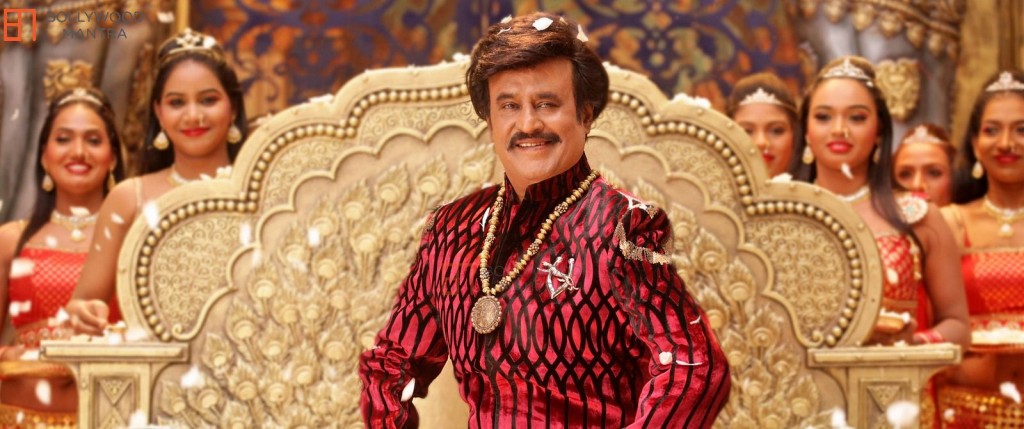Lingaa (Rajinikanth), a petty thief, learns how his grandfather, Raja Lingeswaram (Rajinikanth again), was tricked by the British into sacrificing all his wealth, and realizes he now has to save the dam his grandfather selflessly constructed from a local politician (Jagapathy Babu), who wants it destroyed.
One wonders if a film like Lingaa even needs reviewing. The primary aim of the film overriding any so called cinematic aesthetics is to keep Rajinikanth’s huge fan pace happy. And with the film giving them two Rajinis – one in 1939 and the other in present day India, who are actually grandfather and grandson – there’s more than enough to keep them ecstatic. With Rajini in every frame, there’s also just enough of a story mounted lavishly on a huge scale (not including the terribly tacky CG work in the climax) to keep events going even if the pace is somewhat sluggish and the running time of 175 minutes begins to tell. But with Rajini doing what he has to do, the fans are on cloud nine, the shows are all full, record collections are expected everywhere, and the festivities are on. So in that sense mission accomplished. End of story, end of review.
Still, if one were to actually review the film, then one would have said that the film is a mixed bag. While it throws in many elements into its plot, the safe and typical screenplay makes it appear wafer thin and just about functional. The film, after a lightweight start in the present with stereotypical items like the hero’s intro with a solo song, its focus on comedy (handled ably enough by Santhanam), gets into a higher gear once the 1939 flashback segment kicks in. Inspired by British Army Engineer Colonel John Pennycuick who constructed the Mullaiperiyar dam after mortgaging his property, this portion of the film, even if much too long, still has its share of moments. Rajini is much more at home in the comparatively more human character of the benevolent Raja Lingeswaran who is a king, collector and engineer, and who on his own builds a dam for villagers of 36 villages to secure their future against drought and floods. In fact, these sequences see the actor in Rajini struggling to come out of his huge image. It has to be said he even succeeds in sequences like the one where the villagers meet him and find him living humbly and he forgives them for kicking him out after all he has done for them. Yes, there is an accomplished actor beneath the mask of the superstar. Otherwise, it is at times sad to see a performer so trapped in his image that he becomes a parody of himself. And even if the film is huge, KS Ravikumar lacks the skill and flair of a Shankar and this is invoked in the film as we find references to Sivaji the Boss (2007) and some set pieces even designed similar to the earlier film.
As against the mediocre present day sections, the 1939 portions of the film are plotted much, much better in terms of its characters, treatment and the dealing of its main conflict. Even the obvious mainstream elements work so much better here be it the developing romance between Rajini and Sonakshi Sinha, the confrontation scenes with the British villain (ineffectual performance by him though), and the well executed train fight. The dialogue cleverly weaves in patriotic dialogue, a strong spiritual philosophy of living a simple and kindly life, a memorable punch line or two or more (I have not failed. I have postponed my success) with elements of Rajini’s life outside of the screen. So yes, the script weaves in a sequence where Raja Lingeswaran celebrates his birthday, and a happy birthday song is sung to him and with the film releasing on the superstar’s birthday, the fans in the theatre erupted with glee! And as the Rajini character is hailed as a messiah, everyone suggests to him that he could make it right to the top in politics if he so desired. Clearly echoes of real life here.
Of the rest of the cast, though the heroines are functional, Sonakshi Sinha comes off better. Photographed beautifully, she breathes some life into a character of a village belle with some spunk and is endearing. Anushka Shetty is handicapped by an inconsistent characterization. If on one hand, she is a smart journalist involved in sting operations, on the other, her romantic sequences with Rajini are dull and she appears the perfect stereotypical bimbo in them. The huge supporting cast do their bit well enough, particularly K Vishwanath and Radha Ravi making a strong impact. However, the antagonists in both stories are weak and this somewhat dilutes Rajini’s victories over them. This is a major shortcoming in the film. Jagapathy Babu, in particular, makes no impression at all.
The other major disappointment is that AR Rahman’s music fails to make the impact it should, both in the songs and in the background as well. Otherwise on the technical side, one has to make a mention of Rathnavelu’s camerawork and Sabu Cyril’s lavish production design in some of the sequences. One has to mention that merely having an old steam engine train and some antique cars doesn’t make for authentic period recreation. Rajinikanth is shown reading Joseph Campbell’s Hero With a Thousand Faces (yes, we get the connection) a decade before it was actually published and the look and styling of the characters is nowhere 1939. But then audiences in our films have never cared about these things and they will not here either.
I am not going to rate this film. But what I can say is that as a film for Rajini’s fans, it qualifies for a 80% plus score. But if I were to delve more into its cinematic content and filmmaking aesthetics, I’d have to give it about 37% at most.
Tamil, Action, Drama, Color


